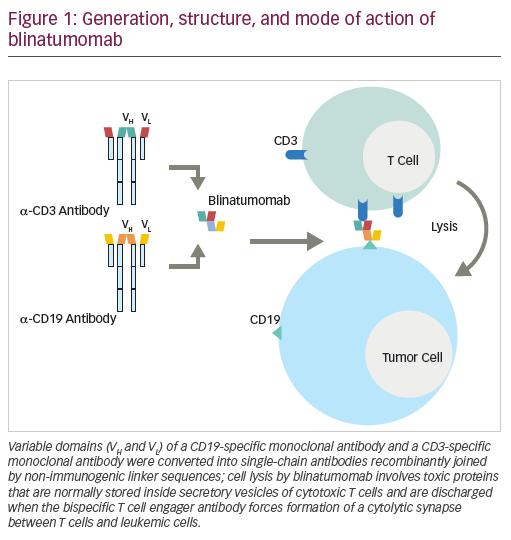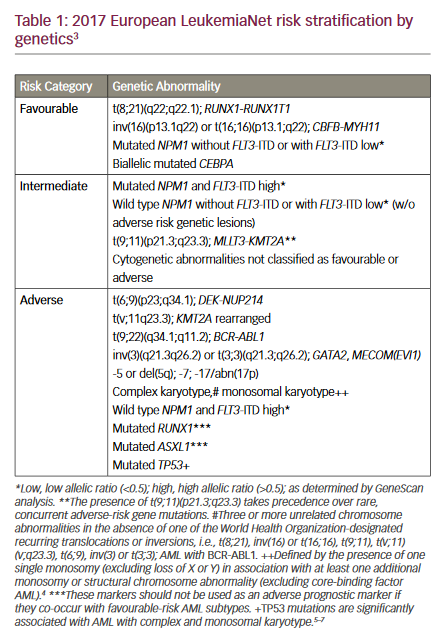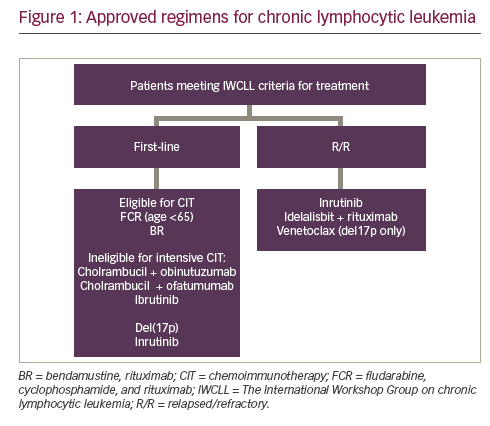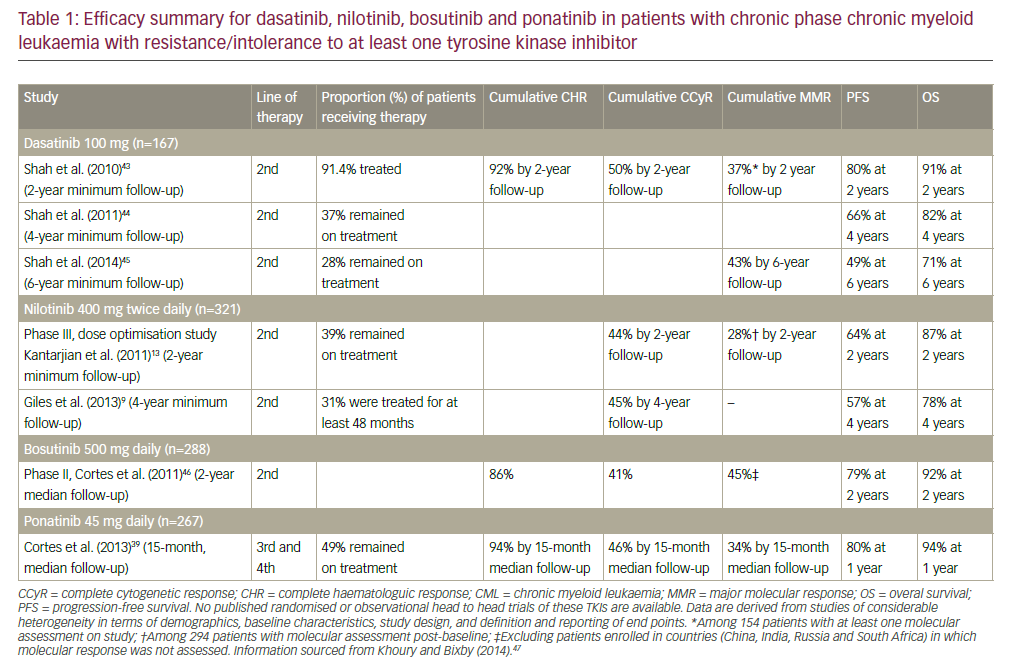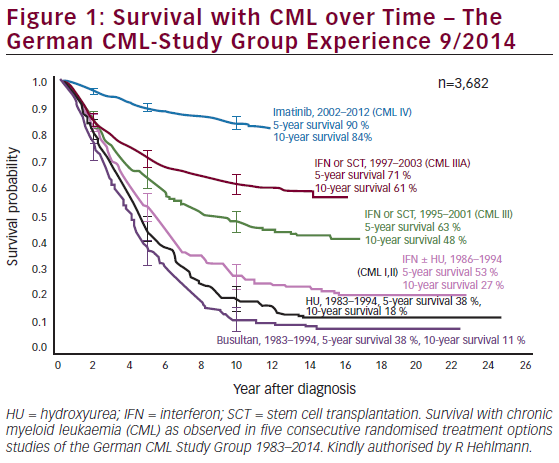Chronic myeloid leukemia (CML) is characterized by the uncontrolled proliferation of hematopoietic cells carrying the Philadelphia chromosome (Ph), the product of reciprocal translocation between chromosomes 9 and 22, t(9;22)(q34.1;q11.2). Its molecular counterpart, the resultant BCR-ABL fusion gene, encodes a constitutively active form of the ABL tyrosine kinase (TK) that induces malignancy through the activation of multiple signal transduction pathways involved in hematopoietic cell growth and survival. Understanding of the disease pathogenesis made it possible to develop molecularly targeted therapies. One such targeted therapy, imatinib mesylate (Gleevec®, Novartis), was found to be a relatively specific inhibitor of the BCR-ABL TK and effective in blocking the molecular signals contributing to the CML phenotype. Imatinib binds the ABL domain at the ATP-binding site and traps the protein in an inactive conformation to inhibit the kinase activity. Its favorable pharmacokinetic and toxicity profile, paired with its excellent clinical results, rapidly made imatinib the standard frontline therapy for all chronic-phase CML patients.
Evolution of Treatment Regimens
For many years, patients with CML relied on agents such as hydroxyurea and busulfan to improve their quality of life. Later, survival prolongation was achieved through recombinant interferon-alpha alone or in combination with cytarabine and, in some patients, allogeneic stem cell transplants.1,2 In the International Randomized Study of Interferon and STI571 (IRIS), imatinib was found to be superior to interferon-alpha as initial therapy for patients in the early chronic phase. After five years of follow-up, imatinib has resulted in a complete cytogenetic response (CCyR) rate of 82% and a projected rate of death or progression to accelerated- or blastic-phase CML of 7%.2,3 Six-year follow-up data for imatinib use in the IRIS study continue to provide clear evidence of durable responses, with a 0% rate of transformation to accelerated-phase CML or blast crisis between years five and six, and an overall estimated six-year survival rate of 88%.4 Imatinib (400mg/day) is now considered by both the US National Comprehensive Cancer Network (NCCN) and the European LeukemiaNet to be the standard approach for the initial treatment of chronic-phase CML.5,6
However, the development of imatinib resistance has been reported in some patients, with both primary resistance (failure to achieve a desired response at specific times) and secondary resistance (loss of response) reported in a subset of patients. Primary hematological resistance occurs rarely, affecting 2–4% of cases, whereas 15–25% of patients may experience primary cytogenetic resistance.7 Secondary resistance to imatinib is thought to involve acquired evasion of BCR-ABL inhibition by various mechanisms such as mutations in the kinase domain that prevent imatinib binding, or genomic amplification and overexpression of BCR-ABL.8,9
Knowledge of the molecular mechanisms behind imatinib resistance has led to the development of second-generation ABL kinase inhibitors. These second-generation agents have significantly higher potency compared with imatinib and activity against most imatinib-resistant BCR-ABL kinase domain mutants. A number of these kinase inhibitors have entered clinical trials, and two products—dasatinib (Sprycel®, Bristol-Myers Squibb) and nilotinib (Tasigna®, Novartis)—have recently been approved by health authorities in the US and Europe for use in patients with CML experiencing imatinib resistance or intolerance. Intolerance of imatinib is rare, occurring in <1% of patients.2
Second-generation ABL Kinase Inhibitors in Imatinib Failure Dasatinib in Imatinib Failure
Dasatinib is a highly potent multitarget inhibitor of the BCR-ABL kinase and Src family kinases. Dasatinib binds to the ABL kinase in both the active and inactive conformations,10 and in vitro studies have shown that dasatinib has 325-fold increased potency compared with imatinib in cells with wild-type BCR-ABL.11 Successful anti-CML activity in phase I studies led to the phase II START (SRC/ABL Tyrosine kinase inhibition Activity: Research Trials of dasatinib) program. This included a series of trials using oral dosages of 70mg dasatinib twice daily (BID) for CML patients in chronic, accelerated, and blastic phases following imatinib resistance or intolerance.4,12–15 These studies demonstrated the efficacy of dasatinib after imatinib failure. Data from a two-year follow-up of the multinational and multicenter studies are summarized in Table 1. The proportion of patients remaining progressionfree at two years when treated with dasatinib after resistance or intolerance to imatinib was reported at 80%, with 94% overall survival. The trial data show that dasatinib is generally well-tolerated, with thrombocytopenia and neutropenia as the most common grade 3–4 adverse effects.16 While the incidence of grade 3–4 neutropenia and thrombocytopenia are 49 and 48%, respectively, in chronic-phase CML,17 the rates increase as the leukemia progresses, reaching 76 and 82% in accelerated phase12 and ranges of 79–82% and 84–88% in blast crisis. Dasatinib is currently US Food and Drug Administration (FDA)-approved for treating all phases of Ph+ CML following imatinib resistance or toxicity, as well as for Ph+ acute lymphoblastic leukemia (ALL) with resistance or intolerance to prior therapy. Subsequent studies have shown that in the chronic phase, a dose of 100mg once daily is as effective as the initially used dose of 70mg BID, but is associated with significantly fewer grade 3–4 adverse events, particularly myelosuppression and pleural effusion, compared with combined adverse events for 50mg BID, 70mg BID, and 140mg once daily.18 Thus, 100mg once daily has become the standard dose in chronic-phase CML.
Nilotinib in Imatinib Failure
Derived from imatinib, nilotinib has a much higher binding affinity and selectivity for the inactive conformation of ABL kinase. Nilotinib’s inhibitory activity is 20- to 50-fold stronger than that of imatinib in imatinib-sensitive cell lines, and three- to seven-fold stronger in imatinib-resistant cell lines.11,19,20 A phase I dose-escalation trial demonstrated that 400–600mg nilotinib BID was well-tolerated and demonstrated anti-CML activity.21 This was followed by the phase II trial investigating nilotinib 400mg BID orally in patients with all phases of CML who had experienced imatinib failure. Nilotinib was found to be effective in inducing hematological and cytogenetic responses; the data from a two-year follow-up are summarized in Table 2. Under nilotinib therapy, 76.2% of chronic-phase CML patients achieved complete hematological response (CHR) in one month and 40.0% achieved CCyR. Among the patients who achieved major CHR, 84% maintained responsiveness for at least 18 months, with 64% of these responders progression-free. The 18-month survival rate is an estimated 91%. Thrombocytopenia and neutropenia were reported as the most common grade 3–4 adverse effects.17 Although patients with accelerated-phase CML had similar toxicities to those in the chronicphase study,22,23 patients in blast-phase CML experienced higher rates of adverse effects: neutropenia (67%), thrombocytopenia (62%), and anemia (42%).24 In October 2007, nilotinib was granted accelerated approval by the FDA for the treatment of chronic and accelerated phases of Ph+ CML in patients resistant or intolerant to prior imatinib therapy.
Adverse Events Associated with Second-generation ABL Kinase Inhibitors
The toxicity profiles of dasatinib and nilotinib are different. Myelosuppression (particularly grade 3–4 neutropenia and thrombocytopenia) occurs more frequently with dasatinib (70mg BID) than with nilotinib (see Table 3). Biochemical abnormalities were observed as well, including elevated lipase levels in 15% and bilirubin in 8% of nilotinib patients, and hypophosphatemia in 10–15% of patients with either nilotinib or dasatinib. Fluid retention occurs more frequently with dasatinib, particularly pleural effusions; these have been reported in 27% of patients, although in most instances they are mild. The reported rate of grade 3–4 effusions is only 9%.16,17 These agents both have the potential to prolong the QT interval, thus they are not recommended in patients with long QT syndrome, and patients with hypokalemia or hypomagnesemia should have these abnormalities corrected before the start of therapy. Chronic administration of dasatinib caused mean changes of QTcF of 3–6msec (upper 95% confidence interval [CI] <8msec).25 Maximum mean placebo-adjusted QTcF change from baseline was determined to be 18msec (one-sided 95% upper CI 26msec).26 Nilotinib has been associated with a time-averaged mean change from baseline QTcF of 5msec.27
It is unclear to what extent the off-target kinase inhibition contributes to the efficacy, safety, or tolerability of these agents. Both nilotinib and dasatinib inhibit KIT and PDGFR in addition to ABL. Dasatinib can also inhibit the SRC and ephrin receptor (EPHA2) TKs. All of these kinases have physiological functions. For example, the EPHA2 kinases are implicated in hematopoiesis, angiogenesis, and the control of tissue interstitial fluid pressures. To what extent its inhibition may account for the myelosuppression and pleural effusion seen with dasatinib is unknown.28 It is also not known to what extent the myelosuppression may represent the therapeutic effect of the rapid elimination of the malignant clone, as it has been suggested that dasatinib has little if any effect on normal hematopoietic progenitors.
Mutation Dynamics in Sequential Inhibitor Treatments
With the notable exception of the T315I mutation in the BCR-ABL kinase domain, both dasatinib and nilotinib have demonstrated efficacy against most of the kinase mutations conferring resistance to imatinib.11,20,29 T315I mutations represent only 15–20% of all mutations in CML, with any mutations present in roughly 50% of patients after imatinib failure.30–34 Thus, T315I poses a relatively small problem overall, but it remains an important issue because patients with this kinase-domain mutation have very limited treatment options. Many of the observed mutations associated with resistance to a second-generation TKI were already known mutations seen in imatinib failure. With the use of sequential TKI, mutations may occur after dasatinib or nilotinib that were not present at the time of imatinib failure. Some of these mutations have only rarely if ever been reported in association with imatinib resistance (e.g. V299L, T315A). However, mutations developing after exposure to nilotinib or dasatinib appear to occur at a lower rate than those associated with imatinib. Because T315I is resistant to imatinib, dasatinib, and nilotinib, there was concern that using the second-generation TKIs would select for this mutation, but interestingly enough there was no marked increase in T315I development.31 The data on the efficacy and safety of sequential TKI therapy remain limited. Nilotinib administered to CML patients of all phases who have failed both imatinib and dasatinib therapy has shown significant hematological and cytogenetic responses.35 Similarly, dasatinib can induce hematological and cytogenetic responses in patients who have failed both imatinib and nilotinib.36 Knowledge of specific mutations may sometimes guide therapy, as a mutation that might be relatively insensitive to one agent may respond well to the alternative agent.37 Currently, the NCCN recommends mutational analysis in cases of rising bcr-abl levels in order to provide additional information relating to the possible emergence of an abl mutation.5
Front-line Therapy
With the obvious benefits of dasatinib and nilotinib as second-line treatments, studies are investigating the efficacy of these second-generation inhibitors in newly diagnosed chronic-phase CML patients. A greater percentage of patients treated with these second-generation inhibitors achieved CCyR, and responses occurred significantly faster than with imatinib, whether at 400 or 800mg per day. Within three months, over 72% of patients treated with 100mg/day oral dasatinib achieved CCyR, increasing to 94% by six months and 100% by 12 months. Dasatinib was welltolerated, and although cytopenia and neutropenia occur in nearly half of patients who have failed imatinib therapy, only 10% of treatment-naïve patients develop these conditions.14 Among patients treated with 400mg nilotinib twice daily, 96% achieved CCyR within three months, and 100% by six months. Nilotinib was also well-tolerated, with minimal myelosuppression and minor biochemical abnormalities, such as transiently elevated bilirubin.38 These trials have had only a short follow-up over small patient numbers, but from preliminary observations they appear to confer an advantage over imatinib in terms of response. These results are still preliminary and the longterm impact on overall and event-free survival of therapy with these agents remains to be established. Today, imatinib 400mg daily remains the standard therapy for patients with newly diagnosed chronic-phase CML. The secondgeneration ABL kinase inhibitors present options for improving the therapeutic results obtained through imatinib. Further follow-up and additional studies investigating these drugs as front-line therapies are required before they can be recommended as initial therapy outside the context of a clinical trial. These new drugs have expanded our CML options, and hopefully the currently ongoing phase II studies will tell us which drug is the best choice for the patient.







